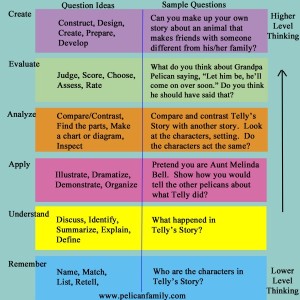
Education Starts Early
You may think you are just talking to yourself when you talk to your newborn, but you’re not. That little one is already observing and listening and learning your language. Talking and singing and smiling…holding, hugging, and gently touching, are all helping your child’s brain grow. At first your conversation is just saying out loud what is happening:
“Mommy’s here”
“ l love you.”
“Look, there’s Daddy.”
“Here is your nose and here are your ears.” And on and on.
But even these early communications with your child can use questions to involve him/her in the conversation.
“Do you see the cat?”
“Where is your red shirt?”
Can you see the bird up in the tree?”
The response at first will be physical — a smile, pointing, looking up. Those early questions are more about just the facts, just labeling and identifying things. This is the first step in questioning. But we don’t want to stop there. We want to change our questions to encourage our children’s thinking. Because, we want our children’s brains to grow and BLOOM.
The Development of Bloom’s Taxonomy
In 1956 a person named Benjamin Bloom, An American Educational Psychologist, worked with several other people to publish a work called the Taxonomy of Educational Objectives, which became commonly known as Bloom’s Taxonomy. “Taxonomy” according to Merriam-Webster.com means classification. The purpose of this was to train educators to help their students progress from lower levels of understanding up to higher level thinking skills. In Bloom’s Taxonomy the levels of dealing with information followed these steps, going from the bottom level 1 being the most simple up to level 6 being the most complicated. It is listed in this order to emphasize the idea that we start with a base of knowledge then move up higher and higher.

6.) Evaluation
5.) Synthesis
4.) Analysis
3.) Application
2.) Comprehension
1.) Knowledge
In 2000 another group revised the order of this classification just slightly and changed some of the labeling in a publication called The Taxonomy for Learning, Teaching and Assessing, edited by Anderson and Krothwohl. Their order was as follows:
6.) Create
5.) Evaluate
4.) Analyze
3.) Apply
2.) Understand
1.) Remember
They kept the first four levels the same, just switched the last two, and used different labels. This made more sense to me, as it seemed after one went through the process of getting new information, understanding what it meant, applying this information to a problem, analyzing the information to understand its parts and uses, then evaluating its usefulness to one’s own and other situations, then the next step was to take this information and perhaps change it or add to it to create something of one’s own making, something new and unique. That seemed to me to be the highest level.
How It Affects You
“Why are you telling me all of this”, you ask, “I’m busy changing diapers.” I’m telling you because you very soon will want to get beyond the Remember or Knowledge level of just “Point to the cat” or “What is this?”. Soon you will want to encourage your child to not just take in all information, but to really think about it more deeply. You can do this by interspersing other kinds of questions which will help your child’s brain develop more and more. Besides, your child will soon push you into this by constantly asking you “Why?”
“OK,” you say, “I like that idea, but how do I do it? How do I know what to ask?” In the chart above we have put together some of the words used in asking questions at each level, and given sample questions about one of our books, Telly’s Story. You can use these ideas with other books or when talking about events or ideas with your children. There are many such charts on the internet. Type in Bloom’s Taxonomy charts for parents in Google images to see them.
Many times we don’t get much beyond the first two lower levels of Bloom’s Taxonomy when we are discussing things with children. But children are great thinkers. They are excited about new ideas and different ways of doing things. Asking them different kinds of questions about what we are discussing might help them develop higher level thinking skills. If we encourage discussion and diversity in thinking, very soon they might be asking us questions that make us think! And while we are having these discussions, we are making connections with them that will last a lifetime.
Listed below are some of the resources I found useful while reviewing the subject of Bloom’s Taxonomy.
http://www.exquisite-minds.com/idea-of-the-week/blooms-taxonomy-critical-thinking-skills/
http://cft.vanderbilt.edu/guides-sub-pages/blooms-taxonomy/
http://www.ibe.unesco.org/publications/ThinkersPdf/bloome.pdf
http://www.learningandteaching.info/learning/bloomtax.htm
